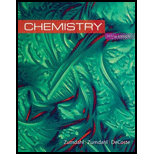
Concept explainers
(a)
Interpretation:
From the given data, the corresponding elements and the number of each nucleons has to be found.
Concept introduction:
The smallest constituent of matter is atom. Each atom consist of subatomic particles called electrons, protons and neutrons. Protons and neutrons are present in the nucleus and called nucleons. A group of atoms having same number of protons are called as an element.
The atomic
Where
(a)
Answer to Problem 107AE
The given element is found to be phosphorus
Number of protons
Number of neutrons
Explanation of Solution
Given,
Atomic number,
Mass number,
The atomic number of the element is equal to the number of protons.
The mass number is equal to the sum of the number of protons and neutrons.
The element with atomic number 15 was found to be phosphorus
(b)
Interpretation:
From the given data, the corresponding elements and the number of each nucleons has to be found.
Concept introduction:
The smallest constituent of matter is atom. Each atom consist of subatomic particles called electrons, protons and neutrons. Protons and neutrons are present in the nucleus and called nucleons. A group of atoms having same number of protons are called as an element.
The atomic symbol for an element can be represented as
Where
(b)
Answer to Problem 107AE
The given element is found to be potassium
Number of protons
Number of neutrons
Explanation of Solution
Given,
Atomic number,
Mass number,
The atomic number of the element is equal to the number of protons.
The mass number is equal to the sum of the number of protons and neutrons.
The element with atomic number 19 was found to be potassium
(c)
Interpretation:
From the given data, the corresponding elements and the number of each nucleons has to be found.
Concept introduction:
The smallest constituent of matter is atom. Each atom consist of subatomic particles called electrons, protons and neutrons. Protons and neutrons are present in the nucleus and called nucleons. A group of atoms having same number of protons are called as an element.
The atomic symbol for an element can be represented as
Where
(c)
Answer to Problem 107AE
The given element is found to be iodine
Number of protons
Number of neutrons
Explanation of Solution
Given,
Atomic number,
Mass number,
The atomic number of the element is equal to the number of protons.
The mass number is equal to the sum of the number of protons and neutrons.
The element with atomic number 15 was found to be iodine
(d)
Interpretation:
From the given data, the corresponding elements and the number of each nucleons has to be found.
Concept introduction:
The smallest constituent of matter is atom. Each atom consist of subatomic particles called electrons, protons and neutrons. Protons and neutrons are present in the nucleus and called nucleons. A group of atoms having same number of protons are called as an element.
The atomic symbol for an element can be represented as
Where
(d)
Answer to Problem 107AE
The given element is found to be ytterbium
Number of protons
Number of neutrons
Explanation of Solution
Given,
Atomic number,
Mass number,
The atomic number of the element is equal to the number of protons.
The mass number is equal to the sum of the number of protons and neutrons.
The element with atomic number 70 was found to be ytterbium
Want to see more full solutions like this?
Chapter 2 Solutions
Chemistry
- Write the systematic name of each organic molecule: structure HO-C-CH2-CH3 O -OH CH3-CH2-CH2-CH2-CH2-C-OH CH3 CH3-CH-CH2-C-OH Explanation Check S namearrow_forwardtheres 2 productsarrow_forwardDraw the major product of this solvolysis reaction. Ignore any inorganic byproducts. + CH3CH2OH Drawing Q Atoms, Bonds and Rings OCH2CH3 || OEt Charges OH 00-> | Undo Reset | Br Remove Done Drag To Pan +arrow_forward
- Draw the major product of this SN1 reaction. Ignore any inorganic byproducts. CH3CO2Na CH3CO2H Drawing + Br Q Atoms, Bonds and Rings OAC Charges OH ОАс Na ဂ Br Undo Reset Remove Done Drag To Pan +arrow_forwardOrganic Functional Groups entifying positions labeled with Greek letters in acids and derivatives 1/5 ssible, replace an H atom on the a carbon of the molecule in the drawing area with a ce an H atom on the ẞ carbon with a hydroxyl group substituent. ne of the substituents can't be added for any reason, just don't add it. If neither substi er the drawing area. O H OH Oneither substituent can be added. Check D 1 Accessibility ado na witharrow_forwardDifferentiate between electrophilic and nucleophilic groups. Give examples.arrow_forward
- An aldehyde/ketone plus an alcohol gives a hemiacetal, and an excess of alcohol gives an acetal. The reaction is an equilibrium; in aldehydes, it's shifted to the right and in ketones, to the left. Explain.arrow_forwardDraw a Haworth projection or a common cyclic form of this monosaccharide: H- -OH H- OH H- -OH CH₂OHarrow_forwardAnswer the question in the first photoarrow_forward
- Ggggffg2258555426855 please don't use AI Calculate the positions at which the probability of a particle in a one-dimensional box is maximum if the particle is in the fifth energy level and in the eighth energy level.arrow_forwardExplain the concepts of hemiacetal and acetal.arrow_forwardBriefly describe a nucleophilic addition.arrow_forward
 ChemistryChemistryISBN:9781305957404Author:Steven S. Zumdahl, Susan A. Zumdahl, Donald J. DeCostePublisher:Cengage Learning
ChemistryChemistryISBN:9781305957404Author:Steven S. Zumdahl, Susan A. Zumdahl, Donald J. DeCostePublisher:Cengage Learning
 Chemistry: The Molecular ScienceChemistryISBN:9781285199047Author:John W. Moore, Conrad L. StanitskiPublisher:Cengage Learning
Chemistry: The Molecular ScienceChemistryISBN:9781285199047Author:John W. Moore, Conrad L. StanitskiPublisher:Cengage Learning Chemistry: An Atoms First ApproachChemistryISBN:9781305079243Author:Steven S. Zumdahl, Susan A. ZumdahlPublisher:Cengage Learning
Chemistry: An Atoms First ApproachChemistryISBN:9781305079243Author:Steven S. Zumdahl, Susan A. ZumdahlPublisher:Cengage Learning Chemistry for Today: General, Organic, and Bioche...ChemistryISBN:9781305960060Author:Spencer L. Seager, Michael R. Slabaugh, Maren S. HansenPublisher:Cengage LearningChemistry: Matter and ChangeChemistryISBN:9780078746376Author:Dinah Zike, Laurel Dingrando, Nicholas Hainen, Cheryl WistromPublisher:Glencoe/McGraw-Hill School Pub Co
Chemistry for Today: General, Organic, and Bioche...ChemistryISBN:9781305960060Author:Spencer L. Seager, Michael R. Slabaugh, Maren S. HansenPublisher:Cengage LearningChemistry: Matter and ChangeChemistryISBN:9780078746376Author:Dinah Zike, Laurel Dingrando, Nicholas Hainen, Cheryl WistromPublisher:Glencoe/McGraw-Hill School Pub Co





